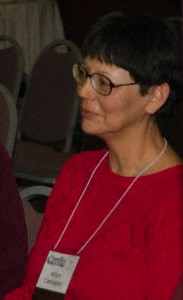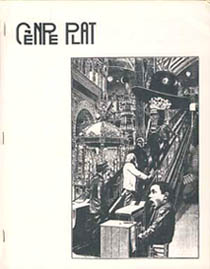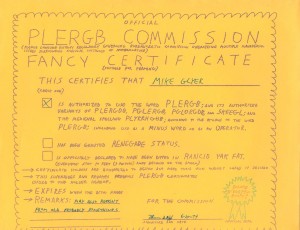File 770 landed on the fortunate side of another close count but must be using up its nine lives awfully fast. I’m afraid to check how many times in recent years the zine has reached the finals by a single vote.
The 2012 Hugo statistics show that Argentus, the fanzine edited by Chicago-area fan Steven H. Silver, also could have made the ballot with one more vote. I know how much he’d have enjoyed being in the race.
However, there was nothing close about the final vote in the Best Fanzine category. SF Signal, the popular blog, started with a 137 vote lead over 2011 winner The Drink Tank and still led by 97 votes when all the traditional fanzines had been eliminated. In the last round SF Signal and The Drink Tank essentially split File 770’s remaining votes with a preference.
The runoff in the Best Fan Artist category, on the other hand, made all the difference and illuminated a dramatic schism among voters.
A Hugo winner needs a majority. Voters rank the finalists in order of preference, then in each round the low vote-getter is eliminated and those ballots are redistributed to the next highest preference still in the race.
Randall Munroe (creator of xkcd) started with a 74 vote lead over winner Maurine Starkey. Munroe picked up only 26 votes in the following four rounds; Starkey collected 92, but still trailed. Then at the very end she got the lion’s share of Steve Stiles’ support which put her over the top. So you had two truly irreconcilable communities voting in this category, the Munroe fans, and the anybody-but-Munroe fans.
Lastly, I wanted to see the response to George R.R. Martin’s endorsements in the fan categories. They didn’t make the final ballot, but where did they end up? Here’s what Martin wrote on his Livejournal in January:
Some of my own favorites include PAT’S FANTASY HOTLIST, THE WERTZONE, MAKING LIGHT, THE BLOG OF THE FALLEN (okay, he doesn’t like my stuff, but it’s still a good read), STOMPING ON YETI, CHEESE MAGNETS, HATHOR LEGACY, and PUNKADIDDLE. And for Best Fan Writer, I’d suggest you consider some of the folks who write for these blogs and e-zines, including Patrick St. Denis, Adam Whitehead, Adam Roberts, and John J. Miller.
Patrick St. Denis and Adam Whitehead and their blogs did reach the top 15. (I’ve added links beside their names.) None of the others got over the event horizon.
Best Fanzine (329 ballots cast)
83 The Drink Tank, edited by Christopher J Garcia and James Bacon (25.23%)
42 Banana Wings, edited by Claire Brialey and Mark Plummer (12.77%)
39 Journey Planet, edited by James Bacon, Christopher J Garcia, et al. (11.85%)
38 SF Signal, edited by John DeNardo (11.55%)
37 File 770, edited by Mike Glyer (11.24%)
——————————————————————–
36 Argentus (10.94%)
30 Challenger, edited by Guy H. Lillian III (9.12%)
29 Yipe! (8.81%)
26 The Wertzone (7.90%)
17 Chunga (5.17%)
17 Pat’s Fantasy Hotlist (5.17%)
15 StarShipSofa (4.56%)
13 A Dribble of Ink (3.95%)
13 eI (3.95%)
12 The Coode Street Podcast (3.65%)
12 SF Commentary (3.65%)
12 SF in SF (3.65%)
Best Fan Writer (363 ballots cast)
63 Christopher J Garcia (21.67%)
56 Jim C. Hines (15.43%)
51 Steven H Silver (14.05%)
43 Claire Brialey (11.85%)
41 James Bacon (11.29%)
——————————————————————–
37 James Nicoll (10.19%)
30 Cheryl Morgan (8.26%)
25 Adam Whitehead (6.88%) [The Wertzone]
23 Mark Plummer (6.34%)
20 Abigail Nussbaum (5.51%)
20 Mike Glyer (5.51%)
15 David Langford (4.13%)
13 Patrick St. Denis (3.58%) [Pat’s Fantasy Hotlist]
13 Guy H. Lillian III (3.58%)
13 Mette Hedin (3.58%)
Best Fan Artist (217 ballots cast)
49 Steve Stiles (22.58%)
41 Maurine Starkey (18.89%)
25 Spring Schoenhuth (11.52%)
25 Taral Wayne (11.52%)
20 Brad W. Foster (9.21%)
20 Randall Munroe (9.21%)
——————————————————————–
14 Frank Wu (5.11%)
14 Sue Mason (6.45%)
10 Alan F. Beck (4.61%)
10 Dan Steffan (4.61%)
9 Kurt Erichsen (4.15%)
9 Dave Hicks (4.15%)
9 Dick Jenssen (Ditmar) (4.15%)
9 D West (4.15%)
9 Delphyne Woods (4.15%)







